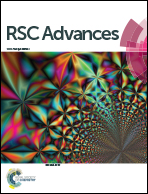Magnetic nanoparticle-supported ferrocenylphosphine: a reusable catalyst for hydroformylation of alkene and Mizoroki–Heck olefination†
Abstract
We present dopamine (dop) conjugated bis(diphenylphosphino)ferrocenylethylamine (BPPFA) functionalized magnetic nanoparticles (Fe3O4). A ferrocene ({η5-C5H4-PPh2}Fe{η5-C5H3-1-PPh2-2-CH(Me)NH-CH2-CH2-4Ph-1,2-OH}) ligand (dop-BPPF) has been prepared by reaction of (1-[1′,2-bis(diphenylphosphino)-ferrocenyl]ethyl acetate) and dopamine hydrochloride to form dop-BPPF, which was characterized by NMR, IR, FTIR, EA and FAB-MS. This ligand was anchored on ultrasmall (6–8 nm) magnetic nanoparticles (MNP) to yield Fe3O4@dop-BPPF. The resulting ferrocenylphosphine on magnetic nanoparticles was characterized by SEM, EDS, XRD, TEM, TGA, and VSM. The magnetic nature of the materials was investigated. Fe3O4@dop-BPPF exhibits very high catalytic activity for the Pd-catalyzed Mizoroki–Heck reaction and exceptionally high regioselectivity for the Rh-catalyzed hydroformylation reaction with branched aldehydes (up to > 99%). The potential of this Fe3O4@dop-BPPF as a reusable catalyst has been studied for the Mizoroki–Heck reaction, and this catalyst was robustly active even after eleven consecutive cycles.


 Please wait while we load your content...
Please wait while we load your content...